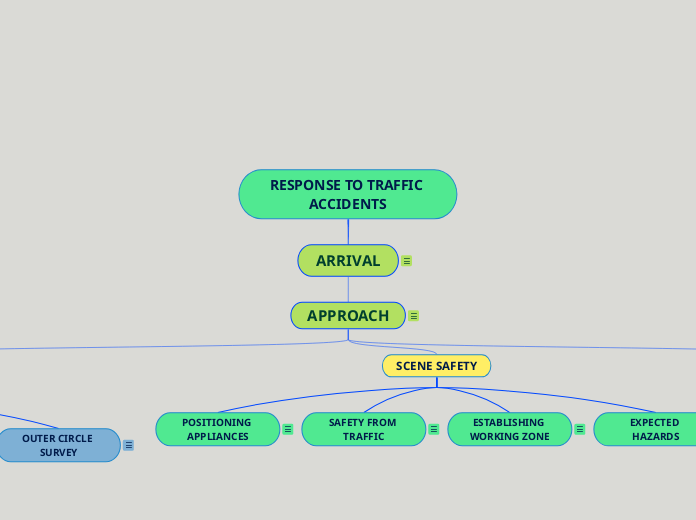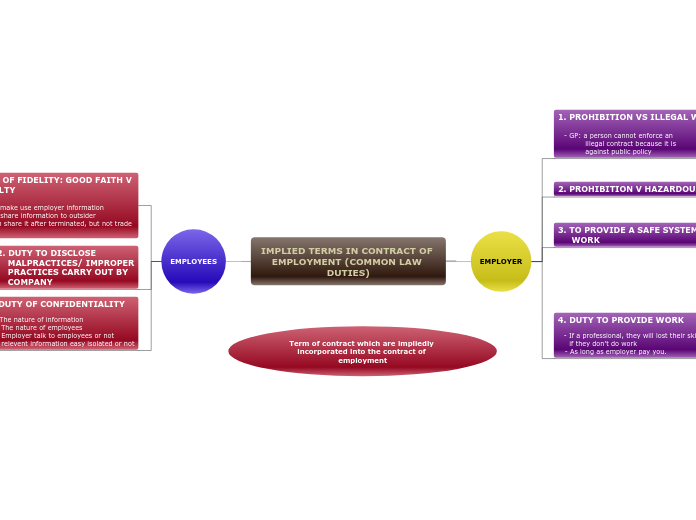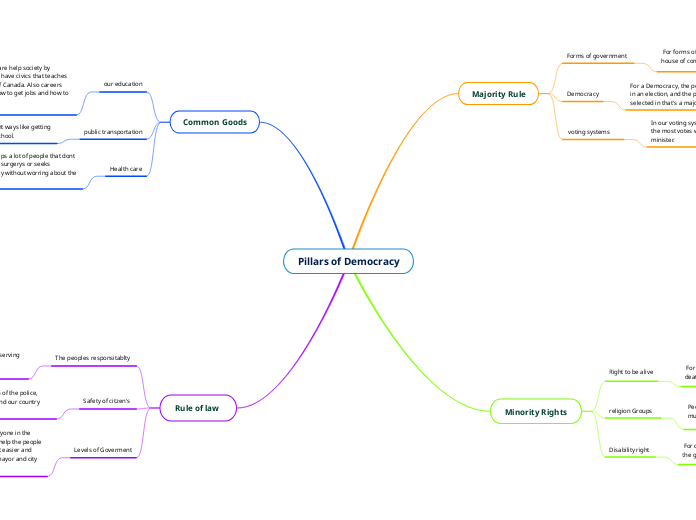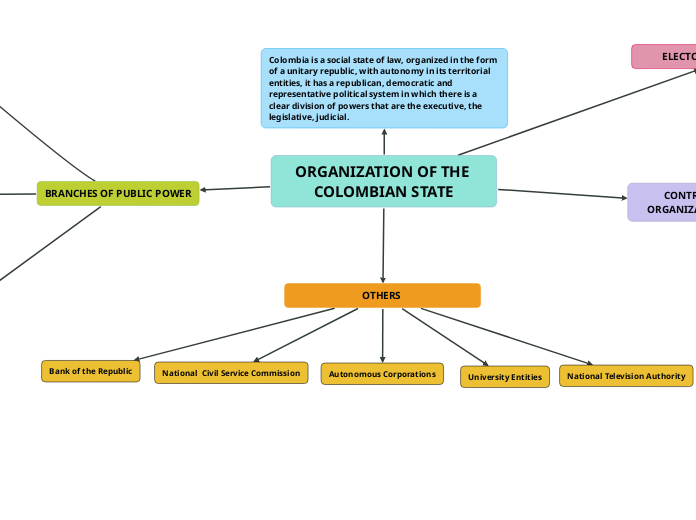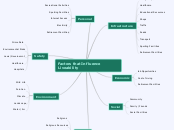RESPONSE TO TRAFFIC ACCIDENTS
ARRIVAL
ARRIVAL
When arriving at the scene of a road traffic accident, the most important thing is safety - be conscious of the approach to the scene, the positioning of appliances and the problems posed by traffic
APPROACH
APPROACH TO SCENE
Approaching an accident site be extremely careful, as conditions, such as poor weather, oil spill or traffic back-up, may all pose dangers.
The approach by appliances arriving at the incident should be slow and controlled for the following reasons:
a. Weather conditions and visibility
b. Road conditions
c. Obstacles and debris
d. Casualties:
- wandering around in a dazed state, or,
- thrown onto roadway
e. Build-up of traffic due to the accident
f. Opportunity to drop off crew member with accident signs
g. Following traffic will be slowed down
A slow approach allows you to make a brief assessment of the incident.
PERSONAL SAFETY
PERSONAL SAFETY
Personal safety includes:
1. proper use of all tools,
2. personal protective equipment:
- High visibility (hi-viz) jacket, vest or surcoat
- Protective clothing (fire tunic and leggings) to protect from sharp edges
- Protective gloves to protect from sharp edges
- Surgical gloves should be worn as appropriate when dealing with casualties. They can be worn under fire/protective gloves
- Head protection should be worn at all times
- Safety boots with protective toe cap
- Eye protection, goggles or safety glasses with helmet visor – goggles or safety glasses are not adequate on their own when using tools
- Respiratory protection as appropriate
- Ear defenders when using certain tools.
3. In addition to making proper use of PPE, each member of a crew must be conscious of his/her own safety at all times when working at an RTA. The following points should be borne in mind:
- Dismount away from traffic
- Stay within safe working area/coned area
- Do not work under unstable vehicles
- Be aware of hazards such as, glass, spilt fuel, battery acid, hydraulic fluid, sharp metal, blood, needles, LPG, hazardous materials, glass dust
- Check the vehicle for any supplemental restraint systems (SRSs), undeployed airbags, seat belt pre-tensioners
- Use proper manual handling techniques
- Change around tool operators when appropriate
- Ensure any emergency personnel have appropriate PPE.
SCENE SAFETY
EXPECTED HAZARDS
Expected hazards
Hazards which can be expected at the scene of a road traffic accident include the following:
- Traffic - personnel should also be alert to emergency vehicles moving at the accident scene
- Road conditions may have contributed to the accident or may be dangerous as a result of the accident.
- Weather - wind, rain, ice and high or low temperatures can all have an effect on the casualty’s wellbeing and on procedures to be used.
- Unstable vehicles - the location and orientation of an unstable vehicle can pose serious problems. The stability of a vehicle may change during an extrication.
- Fires - fuel or vehicle fires should be tackled immediately to protect casualties.
- Tyres - here tyres have been exposed to excessive heat, either from a fire or overheating brake drums etc., there is risk of the tyre flying off the rim with explosive force. An exclusion zone of 30m should be considered.
- Batteries should be disconnected as soon as is practical. Where accessible, the negative terminal should be undone and removed. This would facilitate restoration of power if required, for example operating electric windows. Some vehicles have master/isolation switches for fuel and power which should be operated.
- Fuel leaks can be caused by rupture of the fuel tank or by ruptured pipes (particularly with fuel pumps continuing to operate). Ignitions should be switched off and batteries disconnected. In extreme situations, where substantial amounts of fuel have leaked, it may be necessary to consider laying a blanket of foam, particularly if upholstery has become impregnated with petrol. Otherwise, spilled fuel should be absorbed with appropriate absorbent material. Where there are no sewers, or where there are no environmental considerations, small quantities of leaked fuel may be washed off the road with a high pressure hose-reel. It is important to remove ignition sources, to prevent smoking, and to keep unnecessary personnel out of a danger area where there has been a fuel leak.
- Loads on commercial vehicles may have become unstable as a result of the accident. The stability and content of the loads should be checked as part of the initial appraisal.
- Hazardous materials - if identified on a vehicle or in the area of the accident, appropriate measures should be taken.
- Electricity - if lighting or electricity transmission poles have been involved in a collision, be aware of the danger of live wires.
- Sharp metal may be exposed following the accident or as a result of cutting procedures, either way sharp edges should be covered to prevent injury.
- Airbags, pre-tensioners - he Inner Circle survey should identify any danger within the vehicle.
- Hybrid / electric vehicles - require special procedures to be followed when involved in a road traffic accident due to the high voltages involved (up to 300 volts in some cases) and the nature of the electrolyte used in the batteries.
ESTABLISHING WORKING ZONE
Establishing working zone
A working zone should be established and maintained around the vehicle as early as possible. This zone should be kept free of any tools not in use, first responder bags, stretchers etc. for the duration of the rescue. The zone should be a minimum of 2m wide and can be up to 5m wide. Tools and equipment used at the scene should be carried into the working zone, used, and returned to the tool staging area. Personnel not actively working on the rescue should remain outside this zone until required. The working zone is a theoretical area around the vehicle that should be kept clear of debris, idle tools, spectators and non-essential personnel. The area outside the working zone, which contains the tool staging area and the parts dump, should be kept clear of all personnel not involved in the rescue and should be cordoned off if necessary.
SAFETY FROM TRAFFIC
Safety from traffic
The control of traffic at the scene of an accident is the responsibility of the police.
If the fire service is to control traffic, it should be done in a manner which ensures the maximum possible safety levels for the people doing the traffic control and for all others at the scene.
POSITIONING APPLIANCES
Positioning appliances
Responding appliances should be positioned to protect the casualties and emergency personnel at the scene. The appliance should be parked behind the crashed vehicles, at an angle to the road centre, to deflect traffic, i.e. in fend-off position. Adequate space should be left between a fending-off appliance and the incident for other appliances, and for an equipment/ tool staging area. A second appliance or other fire service vehicle, if available, should be parked in a fend-off position beyond the incident. If a smaller or lighter vehicle is used, it should be parked on the side of the incident which is less likely to be exposed to traffic.
Ambulances should generally park ahead of the scene of the crash. Fire appliances should be positioned close enough to enable hose reels/ jets to be laid out to cover the scene, but should not be so close that exhaust fumes pose a difficulty.
PRELIMINARY SURVEY
PRELIMINARY SURVEY
The preliminary survey will begin before the appliance stops at the scene.
Quickly gather as much information as possible on the hazards and challenges involved and the tasks to be carried out. The preliminary survey involves a dynamic risk assessment. When there are no obvious hazards, have a more detailed assessment done by carrying out inner and outer circle surveys.
OUTER CIRCLE SURVEY
Outer circle survey
One or two members of the crew walk completely around the vehicle. They look in towards the car and out to the perimeter of the scene, checking for casualties, obstructions, hazards, and any potential problems while remaining a few metres away from the vehicle.
INNER CIRCLE SURVEY
Inner circle survey
One or two members of the crew walk around the vehicles involved and closely examine the vehicles and the immediate area for casualties and any hazards.
This survey will help to establish the following:
- that there are no further casualties underneath the vehicles,
- any weak areas of the vehicle due to accident damage that will require additional stabilisation,
- the presence of any fuel or oil from the accident,
- the presence of SRS (Supplementary Restraint System),
- any other situation requiring attention – for example, power lines, the position of catalytic converters.
CASUALTY SURVEY
Casualty survey
Casualty carer carries out a primary casualty survey including:
1. airway,
2. breathing,
3. circulation,
4. C-spine immobilization as necessary.
CASUALTY CARE
Casualty care - the ‘golden hour’
The ‘golden hour’ concept (introduced by Dr. R. Adams Cowley in 1961), recognises that casualties will have a much poorer chance of survival if they are not delivered to definitive care (a hospital operating table) within one hour from the time of the accident.
The ‘golden hour’ includes the time taken for call-out, travel to the incident, extrication and transport to hospital.
IMMEDIATE RELEASE
Immediate release
Occasionally, it may be necessary due to extremely pressing circumstances to move a casualty as a matter of urgency. The following are the circumstances in which this may be done:
- fire,
- submersion
- toxic fumes,
- hazardous materials - direct contact with caustic, corrosive, or poisonous-through absorption substances,
- police request - uncontrolled civil disturbance/terrorist activity,
- medical requirement - on advice from medical personnel.
EXTRICATION
Casualty removal
No injured person should be moved until assessed by an appropriately trained person, unless the casualty or rescuers are in immediate danger.
The objective should be to provide sufficient space for stabilization and immobilisation of the casualty, work to free the trapped person, leading to a safe removal from the scene.
The most common type of rescue involves getting the casualty out of a car on a long spinal board. The following is a formal drill, detailing numbers for the procedure.
CASUALTY SAFETY AND WELFARE
Casualty safety and welfare
During the course of an incident involving an RTA, either the rescue personnel or the first responders in the fire crew will be dealing with the casualty. It is essential that the work of the fire crew to release the casualty does not have an adverse effect on the casualty.
VEHICLE
During rescue – vehicle safety
Vehicle stability
The reason a vehicle is stabilised is to prevent movement, and thus minimise the likelihood of any further injury to the casualty. During the process of releasing a trapped casualty, vehicle parts will be removed or shifted causing a change in the weight distribution. Additionally, rescue personnel will be getting in and out of the vehicle. For these reasons, it is necessary to check the stability of the vehicle regularly.
Vehicle glass management
When glass is being managed, a casualty is vulnerable to glass fragments and to dust that may be generated by cutting glass. It is essential that casualties are protected by hard protection, such as a shield, and by soft protection, such as clear plastic sheeting. Casualties should also be given respiratory protection.
CASUALTY
During rescue – casualty safety
1. Be aware of the effect hazards inherent in the vehicle (such as deployed or undeployed airbags and pre-tensioners) would have on the casualty.
2. Hard protection must be provided to the casualty whenever tools are being used.
3. Constantly chock and block when moving or lifting any part of the vehicle.
4. When using tools above a casualty be very conscious of the possibility of the tool slipping.
5. If metal is being cut or moved, watch very closely to make sure that parts of the vehicle or the tools do not impinge on the casualty.
6. Warn the casualty of any procedure which will be noisy and consider providing ear protection if necessary.
7. Protect the casualty from the weather. Be aware of the effects of wind, rain and temperature on the casualty.
8. When discussing matters concerning the casualty’s condition, be conscious of the fact that the casualty could be listening.
